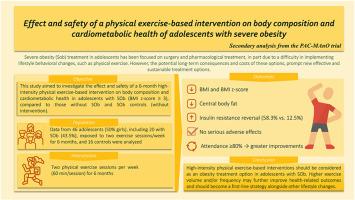Effect and safety of a physical exercise-based intervention on body composition and cardiometabolic health of adolescents with severe obesity. Secondary analysis from the PAC-MAnO trial
引用次数: 0
Abstract
Background
Severe obesity (SOb) treatment in adolescents has been focused on surgery and pharmacological treatment, in part due to difficulty in implementing lifestyle behavioral changes, such as physical exercise. However, the potential long-term consequences and costs of these options prompt new effective and sustainable treatment options. This study aimed to investigate the effect and safety of a 6-month high-intensity physical exercise-based intervention on body composition and cardiometabolic health in adolescents with SOb (BMI z-score ≥3), compared to those without SOb and SOb controls (without intervention).
Methods
Data from 46 adolescents (50 % girls), including 20 with SOb (43.5 %), exposed to two exercise sessions/week for 6 months, and 16 controls were analyzed.
Results
Adolescents with SOb showed a higher decrease and increase in central fat mass (β=-2.3, 95 %CI: 4.8, 0.1) and fat-and-bone-free mass (β = 1.70, 95 %CI: 3.25, 0.15) and a higher rate of insulin resistance normalization (58.3 vs. 12.5 %) after the intervention, compared to those without SOb, with no differences in adverse effects. Adolescents with SOb exposed to intervention also showed improvements in BMI, compared to an impairment in controls (95 %CI: 2.64, 0.16).
Conclusion
High-intensity physical exercise-based interventions should be considered as an obesity treatment option in adolescents with SOb. Higher exercise volume and/or frequency may further improve health-related outcomes and should become a first-line strategy alongside other lifestyle changes.
Trail registration
Clinicaltrials.gov NCT02941770.

以体育锻炼为基础的干预对严重肥胖青少年身体成分和心脏代谢健康的影响和安全性PAC-MAnO试验的二次分析
青少年严重肥胖(SOb)的治疗一直集中在手术和药物治疗上,部分原因是难以实施生活方式行为改变,如体育锻炼。然而,这些选择的潜在长期后果和成本促使人们选择新的有效和可持续的治疗方案。本研究旨在探讨为期6个月的高强度体育锻炼干预对SOb青少年(BMI z-score≥3)的身体成分和心脏代谢健康的影响和安全性,并与没有SOb和SOb对照组(没有干预)进行比较。方法对连续6个月每周进行两次锻炼的46名青少年(50%为女孩)和16名对照组的数据进行分析,其中20名为SOb(43.5%)。结果与无SOb组相比,SOb组在干预后中枢脂肪量(β=-2.3, 95% CI: 4.8, 0.1)和无脂无骨量(β= 1.70, 95% CI: 3.25, 0.15)和胰岛素抵抗正常化率(58.3比12.5%)的下降和增加更高,不良反应无差异。与对照组相比,接受干预的SOb青少年的BMI也有所改善(95% CI: 2.64, 0.16)。结论以高强度体育锻炼为基础的干预措施可作为青少年SOb肥胖治疗的一种选择。更高的运动量和/或频率可能会进一步改善与健康相关的结果,应该与其他生活方式的改变一起成为一线策略。临床试验注册:clinicaltrials .gov NCT02941770。
本文章由计算机程序翻译,如有差异,请以英文原文为准。
求助全文
约1分钟内获得全文
求助全文

 求助内容:
求助内容: 应助结果提醒方式:
应助结果提醒方式:


